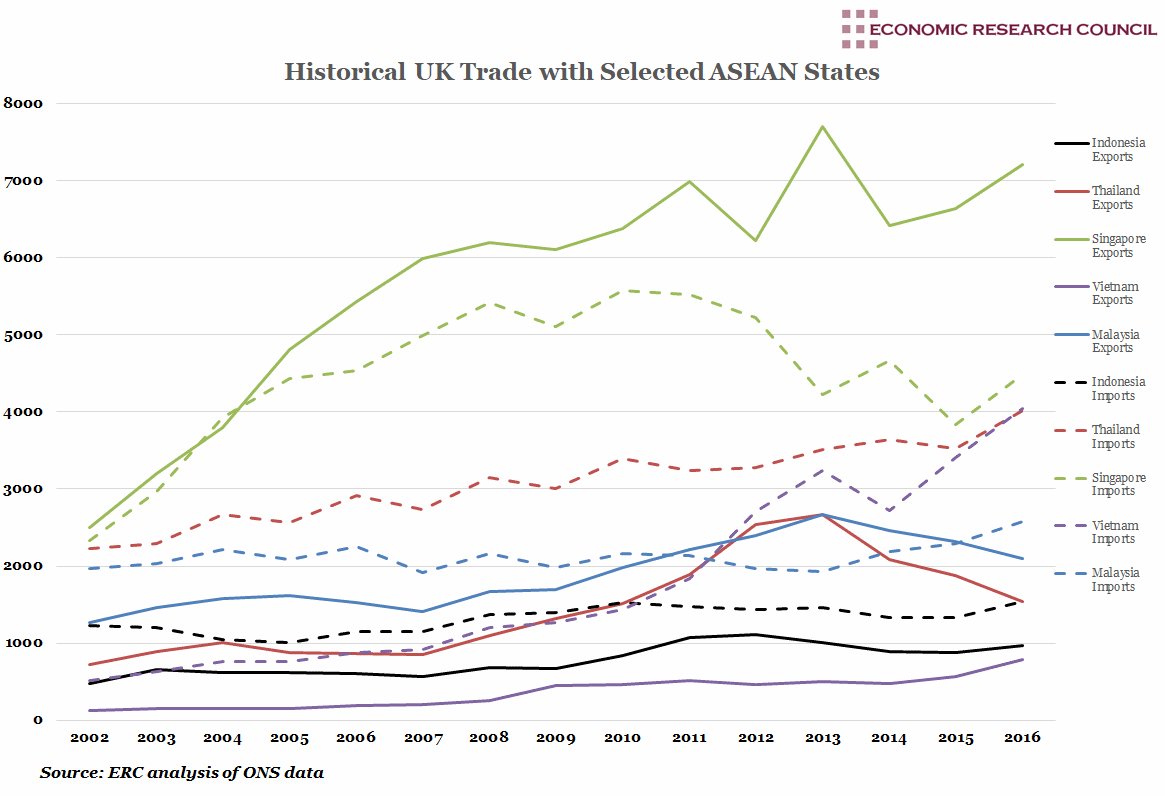
Summary
The chart shows that the UK’s trade with the selected nations from the Association of South East Asian Nations (ASEAN) has increased, with the values of imports from the states at an average of 2.8 times higher and the values of exports from the states an average of 3 times higher in 2016 than in 2002.
Singapore has been the strongest ASEAN trading partner for the UK with imports increasing nearly two-fold, and exports increasing by 2.9 times in the time period shown. Vietnam and Thailand have been steadily exporting more to the UK than they import, as has Indonesia to a lesser extent, while Malaysia has fluctuated between a net importer and a net exporter twice. Moreover, perhaps unexpectedly, the financial crisis of 2008 did not have a significant effect on trade between ASEAN and the UK.
What does the chart show?
The chart shows the gross value of exports from and imports to the UK, focusing on the UK’s five biggest trading partners in the ASEAN region. The solid lines represent exports from the UK and the dotted lines represent imports to the UK. The data measures both goods and services in £millions between 2002 and 2016. The data originates from the Office of National Statistics.
Why is the chart interesting?
As Britain leaves the EU, strengthening global trade links is a key priority, and burgeoning ties with the ASEAN community are being prioritised by the Department for International Trade. This has been undertaken through ministerial visits (recently Greg Hands visited Singapore and Liam Fox, Thailand) to foster closer working relationships for the UK economy. The ASEAN bloc is currently the world’s sixth largest economy, with an average growth rate of 5%, and the UK government projects it to become the fourth biggest by 2030. Services make up 44% of the total value of British exports with ASEAN countries. ASEAN states imported £311 billion of British services in 2015, a 30% increase since 2010 and demonstrative of the robust demand in the region. It is worth noting that many states in the ASEAN region often send wares which end up in the West to China for ‘finishing’. This would depress the true value of goods produced in the region that are later consumed in the UK.
Singapore
It is evident from the chart that the UK sees Singapore as a gateway to the ASEAN market. Indeed, Singapore has been a stable and valuable trading partner for the UK, which holds historical colonial links with the peninsular. In 2018, 4,000 British companies employ over 50,000 people in the city-state. Singapore was recently ranked by the World Bank as the easiest place to start and run businesses and has long sought equivalence with UK business and legal practices, attracting financial institutions and other businesses with low corporate tax rates. The population of Singapore is too small to support the value of imports shown, meaning that they are likely goods and services that utilise the small city states position as a regional hub.
Thailand
UK imports from Thailand are consistently double or more the value of exports to the nation. In a much-publicised summit earlier this year, Thai authorities signalled their appetite for closer trade relations with the UK post-Brexit, indicating that they would seek a free trade agreement. The UK’s exports to mainly machinery and vehicles to Thailand, and imports mainly food and agricultural products. Thailand is implementing a ‘4.0 industrial strategy’, which has a particular emphasis on moving towards a digital economy, and during Liam Fox’s recent visit he announced that UK’s export credit agency, UKEF, had doubled the finance for British businesses wanting to export to Thailand to £4.5 billion. He also stated that UKEF support would become available in Thai baht.
Vietnam
The growth in imports from Vietnam has been more rapid than for exports to the country. The education industry is closely linked to UK and Vietnam’s trade relations. Vietnam’s international schools are an expanding and popular market for British education companies, in terms of services and equipment. The UK is a popular destination for Vietnamese students, especially for higher education. As a low-wage economy, Vietnam’s clothing production sector has grown immensely, likely aided by the rise in wages in China. The apparel sector is projected to be worth approximately £26 billion by 2018 end, with the young population growing wealthier, more brand-aware and consumer-focused.
Indonesia
It is interesting that trade between Indonesia and the UK is relatively low, considering that Indonesia has the world’s fourth largest population and is South East Asia’s largest economy. However, while Jakarta is an attractive business hub, it is important to note that Indonesia’s trade lies mainly within other East Asian and ASEAN nations, and with the United States. Indonesia is rich in natural resources and hence is a key exporter of oil, gas, rubber and textiles, and imports products such as machinery and equipment, some of Britain’s key exports to other ASEAN nations. However, on a recent trip to Jakarta, British trade envoy Richard Graham MP, commented in the Jakarta Globe on the need to simplify the procurement of foreign work permits among other barriers to trade. He highlighted the need for ‘thinking longer term, [considering the possibilities of] joint ventures [making way for] technology and skills transfer.’.
Malaysia
In recent years, Malaysia has moved away from raw material production and to a more complex technology-driven economy, supported by excellent infrastructure. Its technology sector has been growing swiftly (worth £40 billion in 2016) and UK companies have been part of this growth. Notable UK firms operating in the country are BAE systems and Dyson, who respectively employ 400 and 1,000 local engineers. An area earmarked for future growth is education, with five UK university campuses based there and over 100 international schools delivering a British curriculum. In 2017, it was estimated that over 17,000 Malaysians are studying in the UK currently as well as half a million graduates of British institutions, including the current Malaysian PM.

